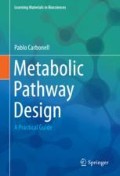Abstract
In this chapter, you will learn about ways for modeling the chemical diversity found in metabolic pathways in nature. Organisms have evolved enzymes, i.e., specialized proteins to carry out chemical transformations that produce the compounds required for life. We have nowadays a good understanding about the mechanisms of natural evolution that allowed the creation of new enzymes and new activities. We are going to model and simulate such behavior by encoding reactions in the same way as we encode a language using words. This will allow us to understand the grammar behind the generation of new reactions. Even more interestingly, we will see how the grammar can be potentially used to enumerate any possible reaction and any possible compound that can be produced in nature. At the end of this chapter, we should have gained a good understanding of the biochemical space that exists in nature.
Access this chapter
Tax calculation will be finalised at checkout
Purchases are for personal use only
Notes
- 1.
- 2.
I invite the reader to learn in detail the rules about SMARTS to understand the big possibilities of using this common representation for chemical transformations.
- 3.
References
Carbonell, P., Planson, A.G., Fichera, D., Faulon, J.L.: A retrosynthetic biology approach to metabolic pathway design for therapeutic production. BMC Syst. Biol. 5(1), 122 (2011). https://doi.org/10.1186/1752-0509-5-122
Caspi, R., Altman, T., Dreher, K., Fulcher, C.A., Subhraveti, P., Keseler, I.M., Kothari, A., Krummenacker, M., Latendresse, M., Mueller, L.A., Ong, Q., Paley, S., Pujar, A., Shearer, A.G., Travers, M., Weerasinghe, D., Zhang, P., Karp, P.D.: The MetaCyc database of metabolic pathways and enzymes and the BioCyc collection of pathway/genome databases. Nucleic Acids Res. 40(D1), D742–D753 (2012). https://doi.org/10.1093/nar/gkr1014
Fillbrunn, A., Dietz, C., Pfeuffer, J., Rahn, R., Landrum, G.A., Berthold, M.R.: KNIME for reproducible cross-domain analysis of life science data. J. Biotechnol. (2017). https://doi.org/10.1016/j.jbiotec.2017.07.028
Judson, P.: Knowledge-Based Expert Systems in Chemistry. Theoretical and Computational Chemistry Series. Royal Society of Chemistry, Cambridge (2009). https://doi.org/10.1039/9781847559807
Khersonsky, O., Tawfik, D.S.: Enzyme promiscuity: a mechanistic and evolutionary perspective. Annu. Rev. Biochem. 79(1), 471–505 (2010). https://doi.org/10.1146/annurev-biochem-030409-143718
Notebaart, R.A., Kintses, B., Feist, A.M., Papp, B.: Underground metabolism: network-level perspective and biotechnological potential. Curr. Opin. Biotechnol. 49, 108–114 (2017)
Rahman, S.A., Cuesta, S.M., Furnham, N., Holliday, G.L., Thornton, J.M.: EC-BLAST: a tool to automatically search and compare enzyme reactions. Nat. Methods 11(2), 171–174 (2014). https://doi.org/10.1038/nmeth.2803
Rahman, S.A., Torrance, G., Baldacci, L., Martínez Cuesta, S., Fenninger, F., Gopal, N., Choudhary, S., May, J.W., Holliday, G.L., Steinbeck, C., Thornton, J.M.: Reaction Decoder Tool (RDT): extracting features from chemical reactions. Bioinformatics 32(13), 2065–2066 (2016). https://doi.org/10.1093/bioinformatics/btw096
Willighagen, E.L., Mayfield, J.W., Alvarsson, J., Berg, A., Carlsson, L., Jeliazkova, N., Kuhn, S., Pluskal, T., Rojas-Chertó, M., Spjuth, O., Torrance, G., Evelo, C.T., Guha, R., Steinbeck, C.: The Chemistry Development Kit (CDK) v2.0: atom typing, depiction, molecular formulas, and substructure searching. J. Cheminformatics 9(1), 33 (2017). https://doi.org/10.1186/s13321-017-0220-4
Further Reading
A good introduction to biocatalysis:
Grunwald, P.: Biocatalysis. Biochemical Fundamentals and Applications. Imperial College Press (2009)
An interesting discussion on enzyme promiscuity and evolution:
Khersonsky, O., Tawfik, D.S.: Enzyme promiscuity: a mechanistic and evolutionary perspective. Ann. Rev. Biochem. 79(1), 471–505 (2010)
Useful introductions to chemoinformatics and associated algorithms can be found in:
Judson, P.: Knowledge-Based Expert Systems in Chemistry. Theoretical and Computational Chemistry Series. Royal Society of Chemistry, Cambridge (2009)
Gasteiger, J., Engel, T. (eds.): Chemoinformatics. Wiley-VCH Verlag GmbH & Co. KGaA, Weinheim, FRG (2003)
Faulon, J.L., Bender, A.: Handbook of Chemoinformatics Algorithms. Chapman & Hall/CRC (2010)
More details about the implementation of chemoinformatics algorithms are available at the sites for the software packages:
The RDKit Python library: http://rdkit.org
The CDK [9] Java library: https://cdk.github.io/
An insightful discussion about chemical space enumeration:
Reymond, J.L., Ruddigkeit, L., Blum, L., van Deursen, R.: The enumeration of chemical space. Wiley Interdiscip. Rev.: Comput. Mol. Sci. 2(5), 717–733 (2012)
Author information
Authors and Affiliations
Rights and permissions
Copyright information
© 2019 Springer Nature Switzerland AG
About this chapter
Cite this chapter
Carbonell, P. (2019). Modeling Chemical Diversity. In: Metabolic Pathway Design. Learning Materials in Biosciences. Springer, Cham. https://doi.org/10.1007/978-3-030-29865-4_4
Download citation
DOI: https://doi.org/10.1007/978-3-030-29865-4_4
Published:
Publisher Name: Springer, Cham
Print ISBN: 978-3-030-29864-7
Online ISBN: 978-3-030-29865-4
eBook Packages: Biomedical and Life SciencesBiomedical and Life Sciences (R0)

